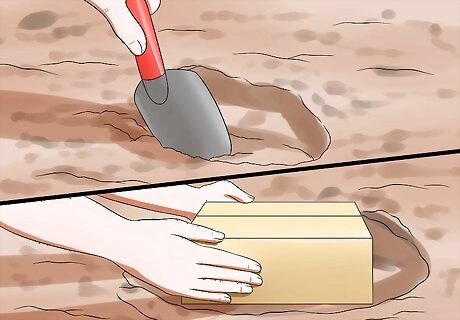
views
- Bury your hamster in a container at least 2 feet (0.61 m) deep so it remains undisturbed.
- Place a grave marker at the site and say a few words if you wish.
- Allow yourself time to grieve the death of your pet.
- Try talking or journaling about your loss to help you cope.
Burial Ceremony

Prepare for the burial. Before you bury your hamster and do any ceremony you feel appropriate you will need to prepare a few things. Proper preparation can make your ceremony go smoothly and will help you say goodbye to your friend in a meaningful way. Gather the following items to prepare for your hamster's funeral: A container for your hamster. Opt for cardboard, cloth or paper containers instead of plastics. Personal items for your ceremony such as flowers or candles. Something to dig a grave for your hamster. A marker for the grave site.

Bury your hamster. After you have found a good site for your hamster to be buried and have collected the materials needed, it is time to bury your hamster. You will need to dig a deep grave for your hamster and fill it in properly to prevent any birds or animals from disturbing it. Dig a hole as deep as you can to place your hamster inside of it. Try to dig at least two feet down. Once your hamster is inside its container, place the container inside the hole. Place stones over the container before filling the top of the hole in with dirt.

Place a marker and complete your ceremony. Once you have finished burying your hamster you will want to place a marker. The marker will help you remember exactly where you have laid your hamster to rest. Placing the marker and finalizing your ceremony will help you to say goodbye to your friend and serve as a reminder of your time together. Your marker can be something simple, such as a stone that you can place in the ground. You can paint, draw, engrave, or carve anything you want to on your hamster's marker.
Dealing With Grief

Experience your grief. Losing a pet can be a difficult and painful time. Many powerful emotions are likely to be experienced during this time and they will need to be worked through. Don't be afraid to experience and process these emotions during the following stages of loss: Denial is usually the first feeling to arise during a time of loss, being a kind of disbelief in regards to the loss. Anger is a reaction to the pain of loss. Bargaining is the phase where someone might start asking “If only...” questions and wondering if they could have saved or prevented the loss in some way. Depression is generally felt right before acceptance. It can be a quiet sadness before letting your pet go. Acceptance is that final stage where you have fully come to terms and integrated your loss.

Talk about it. It might be tempting to deal with your feelings of loss alone. However, talking about your loss with friends and family can help you share your feelings and work towards accepting the loss. Speak with your family and friends to lessen the pain of losing your hamster.

Try writing down your feelings. After the loss of your hamster, you might want to consider writing your thoughts down. Expressing your feelings by writing after the loss of your hamster can help you understand and work through them during grieving process. Try some of the following written formats that you can use to express your feelings: Journaling Poetry Essay or short stories about your hamsters life. Write a eulogy for your hamster that explains how important they were to you.

Take your time. Overcoming the feelings of grief that can come from losing a pet will take different amounts of time for everyone. Don't be in a rush to feel better and allow yourself time to process and come to terms with your loss. It can be a good idea to wait before rushing into getting a new hamster. There is no hurry or set time line that you must feel better by. Listen to yourself and you will know when the time is right for a new hamster.

















Comments
0 comment